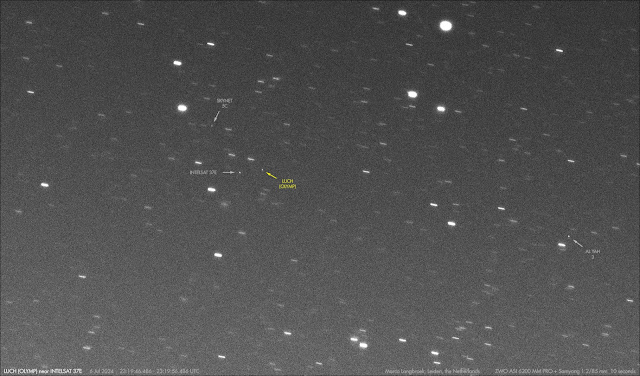 |
| LUCH (OLYMP) 2 imaged at its new location on July 6. Click image to enlarge |
In a previous blogpost I signalled that the Russian military SIGINT satellite LUCH (OLYMP) 2 (2023-031A), also known as LUCH-5X, a satellite that stalks other satellites, started another relocation move on July 22, leaving its position near ASTRA 4A at longitude 4.8 E and drifting west at 0.9 degrees per day.
On July 1, the drift stopped as it arrived at its new target destination at longitude 0.54 W. As expected, it has been placed close to yet another western commercial geosynchronous satellite: the Norwegian satellite THOR 7 (2015-022A).
The image above shows both satellites - plus a couple of other neighbouring ones - as imaged by me from Leiden in the night of July 6/7, when I finally had clear skies again, albeit briefly. The image is a 10-second exposure taken with a ZWO ASI 6200 MM PRO + 1.2/85 mm lens.
At the moment the image was taken, LUCH (OLYMP) 2 and THOR 7 were some 84 km apart. That distance might diminish further: the Russian satellite is still slowly drifting closer to THOR 7.
This is the sixth relocation of LUCH (OLYMP) 2, and the fifth satellite it visits (see diagram above). I expect that it will stay close to THOR 7 for a few weeks and then move on again, possibly to one of the neighbouring satellites (THOR 5 or 6, or INTELSAT 1002), or to a new location altogether.
I also imaged LUCH (OLYMP) 1 (2014-058A), the predecessor of LUCH (OLYMP) 2 (see image below). It has been parked close to INTELSAT 37E (2017-059A) at longitude 18.1 W since September 2022, following an earlier life of frequent relocations (some 30 relocations between 2014 and 2022):
 |
| LUCH (OLYMP) 1 near INTELSAT 37E on July 6. Click image to enlarge |
More on both LUCH (OLYMP) 1 and 2 and their program backgrounds can be found in this article from 2023 by Bart Hendrickx in The Space Review.
As I wrote in a previous blogpost, what LUCH (OLYMP) 2 and its predecesssor LUCH (OLYMP) 1 are doing so close to commercial satellites is an interesting issue. To name a few possibilities: they might be gathering information to map contact networks; geolocating targets that use the satellites; eavesdropping on data communications; prepare for or actually do jamming or spoofing activities; or checking these satellites for vulnerabilities that might provide a means to disable them, might need come.

